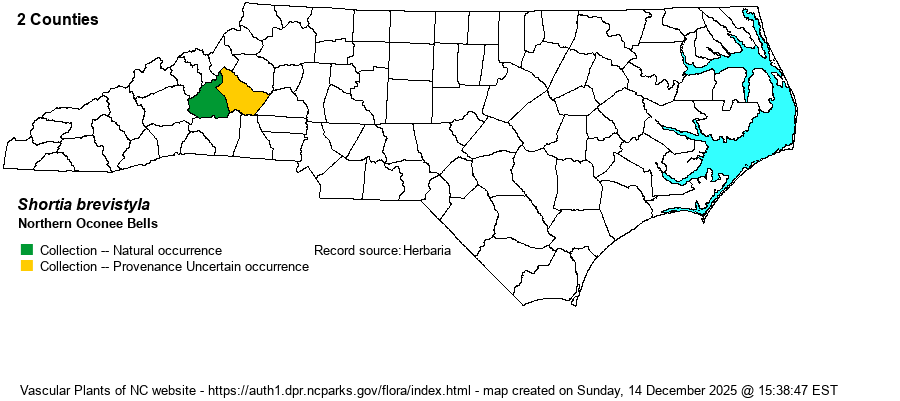| Author | (P.A. Davies) L.L. Gaddy | |
| Distribution | Weakley (2020) has tentatively moved this taxon to full species status, as S. brevistyla -- "Though the morphological characters are relatively minor and partially overlapping, their correlation with disjunct ranges and their likely influence on pollination and reproduction influence me to provisionally accept species rank, pending further research." It occurs as a native only in McDowell County, with probably transplanted populations in neighboring Burke County.
Endemic to McDowell County, NC.
| |
| Abundance | Locally uncommon; scattered populations in just this single county. This is a State Threatened species. | |
| Habitat | The species occurs only in cool, moist, shaded microhabitats, generally along rocky stream banks, deep ravines, and steep slopes beneath various evergreen Rhododendron species. These are typically in the Acidic Cove Forest natural community. | |
| Phenology | Blooms in March and April, and fruits in July and August. | |
| Identification | This is a low-growing sub-shrub with fairly large and glossy evergreen leaves. The several leaves are somewhat rounded, but are more square- or rectangular-shaped with rounded corners, averaging 2.5-3 inches long and nearly as wide. The similar Galax (Galax urceolata), which can grow with it, has thinner leaves that are clearly round or orbicular in shape; both have somewhat serrated leaves. The inflorescences are completely different, as Shortia has large white flowers growing singly on naked stems that are up to 4-5 inches tall. Several such stems and flowers are found on each plant, and the flowers (with five petals) are typically 1-inch across. This showy but scarce species should not present identification problems; however, you are not likely to discover any new (wild) populations. To see it, you likely will have to visit known locations. This species, formerly considered a variety, has "Style 6-10 (-12) mm long, about 1.3-1.5× as long as the stamens (the filaments generally 5-7 mm long); corolla lobes 14-17 mm long" (Weakley 2020); S. galacifolia has "Style (10-) 12-18 mm long, about 2× as long as the stamens (the filaments generally 6-9 mm long); corolla lobes 16-25 mm long" (Weakley 2020). The ranges are separate, with S. galacifolia essentially just to the west, known currently as native populations east to Transylvania County. | |
| Taxonomic Comments | Originally Shortia was not subdivided into varieties (such as in RAB 1968); but in recent decades most references agree on two varieties -- the nominate S. galacifolia var. galacifolia (in the Tri-state region) and the northern S. galacifolia var. brevistyla (endemic to McDowell County, NC). Weakley (2020) tentatively elevates each variety to full species status, but stating that "Though the morphological characters are relatively minor and partially overlapping, their correlation with disjunct ranges and their likely influence on pollination and reproduction influence me to provisionally accept species rank, pending further research." The website editors tentatively follow Weakley (2020), though still believing that both taxa are likely conspecific. NatureServe seems to be more sensible, at least to the website editors, and has these taxa as varieties only.
| |
| Other Common Name(s) | Shortia | |
| State Rank | S2 | |
| Global Rank | G2 | |
| State Status | T | |
| US Status | | |
| USACE-agcp | | |
| USACE-emp | | |

